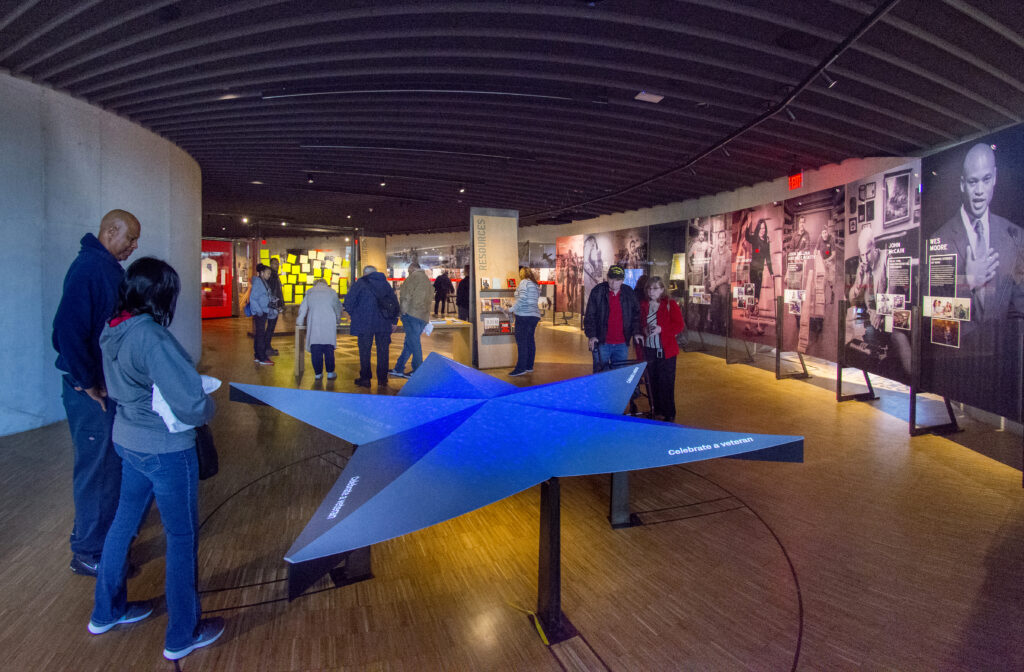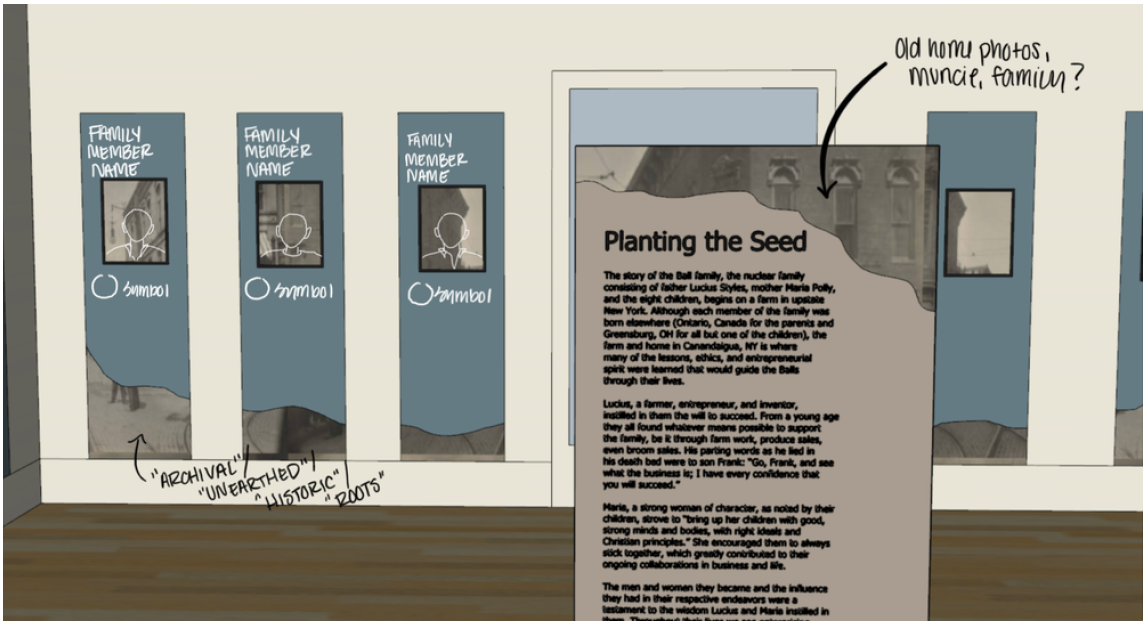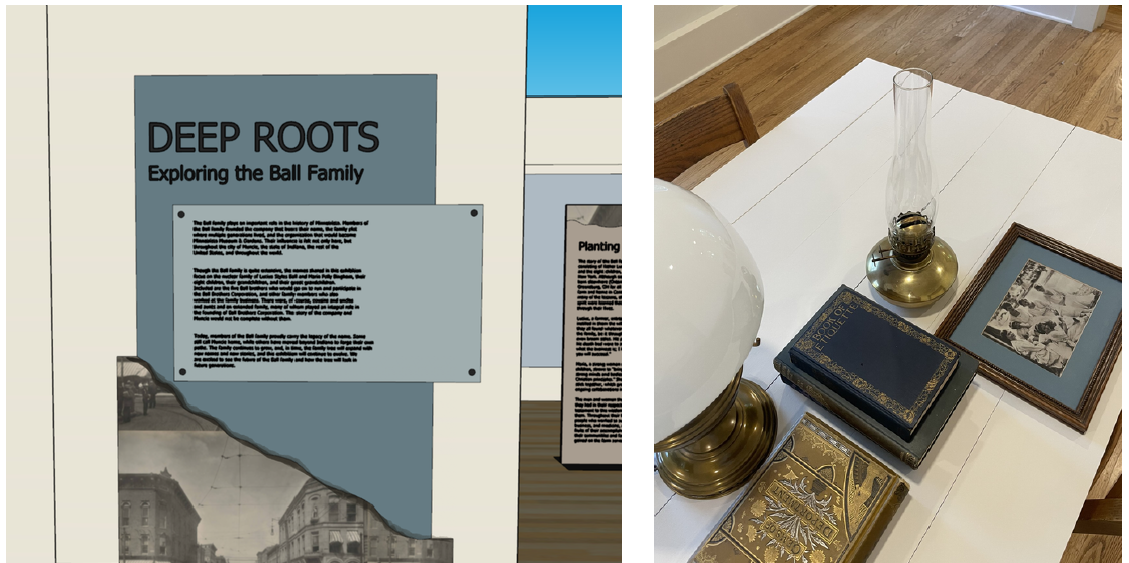In this article, museum exhibit designer and 2024 Exhibit Professionals Conference Fellow Hannah Bender reflects on the ideas and inspiration that she has gathered for a new project – “Deep Roots: Exploring the Ball Family Tree.” Learn how her experiences and discovers through research, participation in AMM 2024 Conference sessions, and exploring museums in Columbus, OH, have informed her design plans.
As an emerging museum professional, trying to create history exhibits in an engaging and visually dynamic way has proved to be one of my most challenging hurdles. I once thought that a successful history exhibit would have to include flat textures, unsaturated hues, and simple designs. Over the past year working at Minnetrista Museum and Gardens, visiting other museums, and recently attending AMM’s conference “The Way Forward,” I have learned otherwise.
After visiting the National Veterans Memorial and Museum in Columbus for the first time, I was inspired by their dynamic and engaging exhibit design. Visitors were met with layers of saturated colors, encouraged to interact with several of the components, and were delivered important historical content in a visually compelling way. I found myself taking pictures of panels and cases throughout my entire visit, noting the aspects of the displays that I wanted to reflect in my own work. Coming home to Muncie, I began implementing several of these ideas into my work on Deep Roots: Exploring the Ball Family Tree.
Minnetrista is one of several legacy projects of the Ball family, makers of the famous Ball mason jars, and was provided to the community by the Ball Brothers Foundation. Deep Roots: Exploring the Ball Family Tree is an in-house exhibit meant to be a permanent installation to highlight the family, their lives, and the impact they had on Muncie, and East Central Indiana. The exhibition itself is set inside Oakhurst, one of the historic homes that once belonged to the family and is now a part of the Minnetrista Heritage Collection. Over the years, the home has been converted into exhibit and gallery space. The second-floor rooms have been changed and trim has been painted, leaving a blank canvas for many Minnetrista exhibitions both leased and original.
Working within this space has posed both challenges and opportunities when designing the exhibit. Working with a historical space that has been altered and is no longer a reflection of the individuals who once lived there while still containing historical elements begs the question, how does one honor the home’s significance without forcing it to be something it no longer is.
Along with the knowledge I took from visiting the National Veterans Memorial, I also reflected on one of the sessions I attended at AMM while designing this exhibit. Listening to “Rethinking Traditional Exhibits in Historic House Museums: Turning a Bedroom into an Immersive Department Store Exhibit,” presenter Ronald Marvin spoke on a similar experience at Wyandot County Historical Society. Hearing how he went about creating an immersive experience on the second-floor space of a historic home was enlightening and inspirational. His resourcefulness when sourcing pieces for the space and the importance he saw in making a case-based exhibit engaging was extremely helpful as I developed our exhibit on the Ball Family.
I always begin my designs by exploring several color palettes, looking at what imagery we may include, and researching how other designers may have approached similar projects. In the space we are working with, there are two original tiled fireplaces, built in benches and cabinets, with original woodwork throughout. Though some of the architectural elements have been painted or refurbished, they are still prominent features in the home. We are planning to include original artifacts in the future, but the first phase of this permanent exhibit is strictly text and reproduction photographs.
While the exhibit is about exploring the Ball family tree, I did not want the design to be so literal as to use tree and root imagery. Rather, I wanted to focus on descriptive themes surrounding the exhibit content and how those could be translated visually. Reflecting on words like archival, unearthed, and historic, I decided to create a consistent visual element that echoed throughout the space. This visual became a torn, almost crumbled section in the text panels that used architectural imagery of the Ball family homes. Activating what would have been negative space creates interest in an intentional way. The imagery is pulled from Minnetrista’s archives and is kept in its original black and white neutral coloring. This could then be used throughout the space and with any applied color pallet. From there I made decisions regarding scale and color with the goal of guiding visitors through the space and indicating where certain areas diverged into new ones.
In conjunction with the text panels that make up this exhibit, we are also incorporating an interactive space where visitors can create their own family tree. The challenge in this space was finding a way to make our audience feel comfortable interacting with the room while also making sure the area complements the rest of the space. Plugging in an IKEA desk and upcycled bookshelf from the early 2000’s was not going to cut it. I am currently in the process of sourcing pieces that can be used in the space that are relevant to the time the home was built and in the home during the time it was occupied. Finding and restoring these items to the extent that they can be used by visitors will ultimately make the exhibit design much more appealing and functional.
This carries weight not only in the room that has the interactive but in the rest of the home as well. In the other spaces I did not simply want to ignore the fireplace or brush past the fact that the exhibit is displayed in a historic home. At the same time, I did not want to commit fully to forcing the rooms to look as they once did. The compromise that worked for us during this exhibit’s development was to acknowledge this in simple yet effective ways. Staging some of the prominent features, like the fireplace, with oil lamps, old picture frames, and books while also utilizing the furniture pieces in the interactive space, allow us to intentionally stage the exhibit.
In the end, this exhibit is still a work in progress as we we continue to work towards its opening. My time spent at AMM and the time I have spent growing in my role as Experience Designer at Minnetrista has opened my eyes to the possibilities that surround exhibit development. I have taken my knowledge of design principles and my newfound knowledge of museum exhibit design to create what I hope to be a memorable experience for our visitors.



